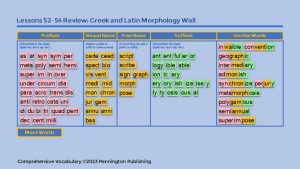FREE Interactive Morphology Walls

18 Interactive Morphology Walls
If you are adding more morphology to your reading and ELA lessons, you will love these FREE Interactive Morphology Walls. Developed as a drag and drop Google slides activity, students combine high frequency prefixes, bases, and suffixes to form big words. Share the slides with students or work off the display projector to discover and create academic language words with 54 high frequency prefixes, bases, and suffixes. The author, Mark Pennington, has selected these 54 morphemes to combine into 18 memorable anchor words in 18 separate Interactive Morphology Walls. For example: un-sub-scribe provides the first 3 morphemes and combines to form the first anchor word. The author’ Comprehensive Vocabulary Grades 4, 5, 6, 7, and 8 programs feature anchor word pictures, definitions, and etymologies. Of course, your students can do the same with the Online Etymology Dictionary.
Now you and your creative students will be able to combine the 54 morphemes into many more words than my 18 anchor words. Think of how many academic language words use the first 3 morphemes (un-sub-scribe) of the 54 in this free resource. And, yes, the Interactive Morphology Walls are easily editable to add more morphemes.
Most of our academic language words have one or more Greek or Latin word parts, so it makes sense to study them. Here is the terminology used with the Interactive Morphology Walls. We classify meaning-based word parts in three ways:
- The base provides the key meaning of the word. A free base can stand on its own as a word, such as form. A bound base can’t stand on its own as a word, such as vis, and it needs another word part before or after it to form a word.
- The word part that comes before a free base or bound base is a prefix, such as uni. Prefixes can’t stand on their own; they need to connect to a free base or bound base to form a word, such as in uniform. When we refer to a prefixes, spell them; don’t say them, because frequently the same prefix is pronounced differently in different words. For example, in the words, complicated and communication, the com prefix is said quite differently, though the meaning and spelling remains consistent .
- The word part that comes after a free base or bound base is a suffix, such as ible. Like prefixes, suffixes can’t stand on their own; they need to connect to a free base or bound base to form a word, such as visible. As with prefixes, spell suffixes; don’t say them, because although they are spelled the same, they are sometimes pronounced differently. Notice that the ible suffix has two vowel sounds and is classified as a stable syllable type.